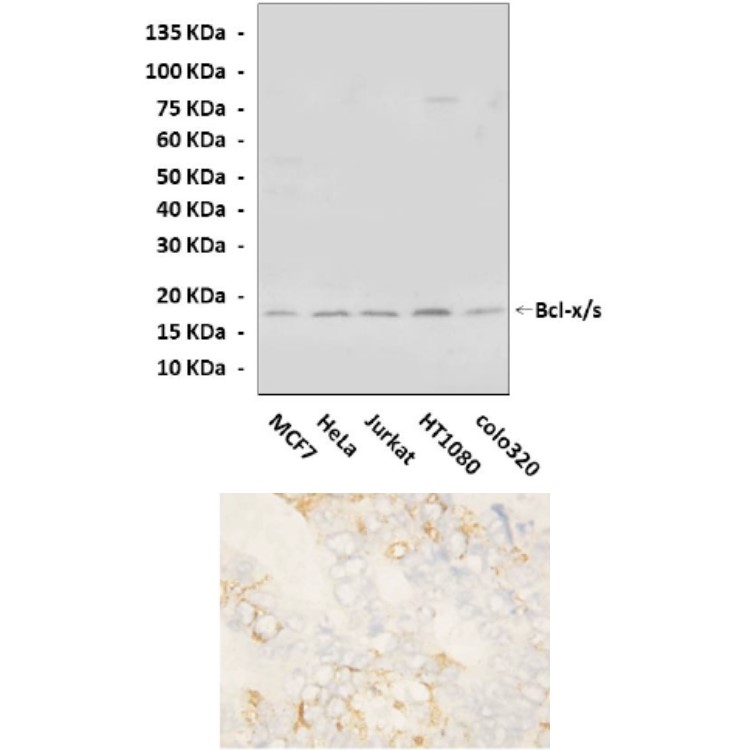Product Sheet CA1232
Description
BACKGROUND
Bcl-2 family proteins regulate and contribute to programmed cell death or apoptosis. It is a large protein family and all members contain at least one of four BH (Bcl-2 homology) domains. The Bcl-2 family of proteins governs mitochondrial membrane permeability and can be either pro-apoptotic or anti-apoptotic. To date, a total of 25 genes have been identified in the Bcl-2 family. Some of the anti-apoptotic proteins include Bcl-2, Bcl-x, Bcl-XL, Bcl-XS, Bcl-w, BAG, and some of the pro-apoptotic proteins include Bcl-10, Bax, Bak, Bid, Bad, Bim, Bik, and Blk. These proteins have special significance since they can determine if the cell commits to apoptosis or aborts the process. It is thought that the main mechanism of action of the Bcl-2 family of proteins is the regulation of cytochrome c release from the mitochondria via alteration of mitochondrial membrane permeability. The pro-apoptotic group of Bcl-2 proteins can be further sub-divided into the structurally diverse 'BH3' only proteins (e.g. Bid, Noxa, Puma and Bad) and the multidomain proteins that share BH1 to 3 (e.g. Bax and Bak). Most Bcl-2 family members contain a C-terminal transmembrane domain that functions to target these proteins to the outer mitochondrial and other intracellular membranes.1
Bcl-x is a member of the Bcl-2 family. By alternate splicing, bcl-x encodes two important protein isoforms, of which the longer Bcl-xL inhibits apoptosis, whereas the shorter isoform, Bcl-xs, promotes apoptosis by acting as a dominant inhibitor of Bcl-2 and Bcl-xL.2 Bcl-x proteins are located at the outer mitochondrial membrane, and have been shown to regulate outer mitochondrial membrane channel (VDAC) opening. VDAC regulates mitochondrial membrane potential, and thus controls the production of reactive oxygen species and release of cytochrome C by mitochondria, both of which are the potent inducers of cell apoptosis.3 Bax is a proapoptotic member of the Bcl-2 family. Bax homodimers favor death and Bcl-2/Bax or Bcl-xL/Bax heterodimers inhibit cell death. Bcl-x functions to support the viability of immature cells during the development of the nervous and hematopoietic systems.4
References:
1. Elmore S.: Toxicol. Pathol. 34:495-516, 2007
2. Boise, L.H. et al: Cell 74:597-608, 1993
3. Heiden, M.G.V. et al: J. Biol. Chem. 276:19414-9, 2001
4. Kim, C.N. et al: cancer Res. 57:3115-20, 1997
Products are for research use only. They are not intended for human, animal, or diagnostic applications.
Details
| Cat.No.: | CA1232 |
| Antigen: | Short peptide from human Bcl-x/s sequence. |
| Isotype: | Affinity-Purified Rabbit Polyclonal IgG |
Species & predicted species cross- reactivity ( ): | Human |
Applications & Suggested starting dilutions:* | WB 1:1000 IP n/d IHC (Paraffin) n/d ICC n/d FACS n/d |
Predicted Molecular Weight of protein: | 16 kDa |
| Specificity/Sensitivity: | Detects endogenous levels of Bcl-x/s proteins without cross-reactivity with other related proteins. |
| Storage: | Store at 4° C for frequent use; at -20° C for at least one year. |
*Optimal working dilutions must be determined by end user.
Products
| Product | Size | CAT.# | Price | Quantity |
|---|---|---|---|---|
| Rabbit Bcl-x/s Antibody: Rabbit Bcl-x/s Antibody | Size: 100 ul | CAT.#: CA1232 | Price: $375.00 |

